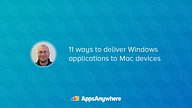Delivering Windows apps to Mac users

In this article, based on our webinar presented by Phil Spitze, we drill down into how to cater for Mac device users while delivering academic software. You can watch the full webinar to the right, or jump to each section via the links below.
The webinar covers 11 key ways to deliver academic software to Mac device users whether through VDI, remote access tools, providing access to Windows machines or other delivery methods. Read on to learn more about cross-platform delivery and how to make it more cost-effective and scalable than simply implementing massive VDI deployments…
How can we leverage existing Mac hardware, whether student or university owned, in order to deliver Windows applications to MacOS devices?
1. Use Bootcamp to dual-boot Mac devices
Dual-booting a Mac device is one of the most common methods of accessing Windows software on MacOS, throughout the consumer, commercial, and educational verticals. This is achieved by using Bootcamp to partition a Mac's hard drive and install Windows as a secondary operating system.

2. Deliver apps through Windows VMs
Virtual machines (VMs) use virtualized desktops to run and deploy software titles. The virtualization of the desktop and the running and executing of apps are all carried out server-side. This is then pixel-streamed to end devices meaning Windows VMs is a highly effective method of delivering cross-platform. Following are examples of technologies capable of delivering virtual desktops:
- Parallels RAS
- VMware
- VirtualBox
Pros of using existing Mac hardware to deliver software:
- Native Windows experience
- Utilizing existing hardware
- Licenses may be included
Cons of using existing Mac hardware to deliver software:
- Not all hardware is capable
- Set-up can be complicated
Perhaps a more analog solution than usual, universities can deliver software to Mac-using students and faculty by simply providing access to Windows devices. Whether this be through university hardware loan programs or remote access technologies, sometimes the best way to deliver to Macs is to not deliver to Macs!
3. Loaner laptops
Device loan programs are popular in universities for many reasons. Because of this, many universities may already have a bank of machines ready for loan. As long as they are Windows machines, using these loaner devices is an effective way of reducing spend on expensive VDI-style solutions by removing the need for cross-platform delivery.
4. Lease-back programs
Another way to avoid cross-platform delivery by providing access to Windows devices is through lease-back programs. These programs work through purchasing hardware upfront and leasing it back to students as required. An added benefit of this is that machine management and maintenance can be covered by students' leasing payments. It is, again, worth noting that these devices must be Windows in order for this method to work.
5. Remote access to lab computers
Providing a secure off-campus connection to Windows machines in university labs is another way of avoiding cross-platform delivery. While security is a consideration and VPNs are advisable, it is possible to deliver software to Macs in this way without needing any other delivery technologies if the remotely accessed lab machines are imaged with the requested software.
Pros of providing access to Windows devices:
- Native Windows experience
- Campus-owned and managed
Cons of providing access to Windows devices:
- Extra upfront hardware investment required
- Risk of hardware abuse/damage
- Scheduling conflicts in machine availablity
Use virtualization solutions hosted on-premise to deliver Windows applications to Mac devices. So which solutions are available to be hosted on-premise and how do they stack up?
6. Virtual desktop infrastructure (VDI)
Deliver software through full virtual desktops. Whether persistant or non-persistant, VDI enables cross-platofrm delivery by executing server-side and pixel-streaming the end result. This is by far the most common solution used by universities to deliver Windows applications to Mac devices or provide any cross-platform delivery. The two most commonly used VDI solutions in universities are:
- VMware Horizon View
- Citrix Virtual Desktop (XenDesktop)
7. App Remoting
App remoting can be likened to a 'slimmed down' version of VDI, often allowing multiple users to access software form the same instance of a virtual desktop. It is essentially VDI but isn't limited to a one-to-one ratio of users to virtual machines. Examples of app remoting are:
- Citrix Virtual Apps (XenApp)
- Parallels RAS
Pros of delivering with on-premise hosted solutions:
- Native Windows experience
- Campus-owned and managed delivery estate
- Centrally managed virtual desktops
Cons of delivering with on-premise hosted solutions:
- Very expensive!
- Large hardware investment commitment
- Expensive, specialist staff required for maintenance and management
Advancements in technology now permit fully cloud-hosted VDI deployments. Lower upfront hardware investment, pay-as-you-go usage models and partially/totally absorbed costs mean that cloud-hosted solutions are much more cost-effective and scalable than on-premise solutions. This positions cloud-hosted VDI as an effective technology for delivering Windows applications to Mac device users. The following are examples of cloud-hosted solutions:
8. Microsoft Azure: Azure Lab Services
Azure Lab Services has been designed to be, as the name suggests, a virtual lab for students to access their software. It is personalized and fully-hosted in Microsoft Azure.
9. Microsoft Azure: Windows Virtual Desktop (WVD)
Windows Virtual Desktop is the only solution capable multi-session Windows 10 delivery. It is able to totally absorb some of the ‘hidden costs’ of VDI, such as CALs, hardware investment, specialist staff and more. It has been designed around higher education, features a versatile pay-as-you-go usage model, and is one of the more scalable technologies.
10. Amazon AWS: WorkSpaces
Amazon WorkSpaces is Amazon's VDI offering and it's available fully-hosted in AWS. It is free to impliment boasts all the capabilities of traditional VDI, partially absorbed hidden costs, and a pay-as-you-go usage model.
11. Amazon AWS: AppStream 2.0
AppStream 2.0 is described as Amazon's 'fully managed application streaming service'. It is built on AWS and it capable of providing apps or full non-persistent desktops.
Pros of delivering with cloud-hosted solutions:
- Native Windows experience
- No data center investment
- Always current virtual hardware
Cons of delivering with cloud-hosted solutions:
- Not campus owned
- Variable costs
- Server OS

How AppsAnywhere can help...
What features of AppsAnywhere help deliver Windows apps to Mac devices?
AppsAnywhere has a number of features that can help universities better deliver software applications to Mac devices and their users. Contextual detection can identify whether users are on or off domain or using campus networks to offer insight on proper delivery methods. AppsAnywhere can also detect geolocation, Active Directory information, operating system plus even more granular data points. All this information collectively gives IT a clear idea of how to deliver to any given context, one of which being delivering Windows apps to Mac device users. With all the relevant information IT can select any of the previously mentioned 11 methods of delivering software to Macs depending on whichever is the most appropriate.
What are the benefits of AppsAnywhere over other solutions?
So how does AppsAnywhere compare to other solutions and what does AppsAnywhere offer that other technologies don’t?
Easy to use campus app store
One mistake often made by universities in cross-platform delivery is not enough consideration towards user experience; many universities are capable of delivering cross-platform, but with a compromised UX. AppsAnywhere has been designed from the ground up for higher education to offer the least complex and best user experience possible, allowing students to access software in the same way every time regardless of device, location, operating system or otherwise.
Free your windows apps from the OS
Using AppsAnywhere to enable cross-platform delivery allows IT to choose from a range of technologies such as VDI or web apps to untether software titles from operating systems and provide more flexible access to your students.
Manage and update apps immediately
Without the need for imaging or other legacy solutions, universities are able to update, manage and maintain applications in real-time rather than having to wait for mid-semester breaks. This means students can always have access to the latest versions of software titles and the latest security patches can be added as soon as they’re release. This is also helpful in providing access to plugins and extensions.
Deliver apps on demand
Context detection and smart prioritization allow AppsAnywhere to identify user context and select the most effective delivery method. Previously, for complex cross-platform delivery, students may need to put in requests for software ahead of time with IT to leave time for installation or to gain access to a loaned machine. Now they can launch Windows apps on Mac devices on-demand for immediate access.
Simplify VM management
AppsAnywhere can provide data on VM usage, and whether IT is over or under subscribed when it comes to VDI licenses. Not only is AppsAnywhere a useful tool in itself for VM management, but it can help expose and highlight opportunities to reduce the use of VMs or redirect their use to more appropriate delivery contexts.
Deliver MacOS installs to MacOS
Another benefit of AppsAnywhere’s contextual detection is that it can detect if a user is on a Mac device and deploy PKG/DMGs, allowing users to install a Mac version of a software title if available.
Link out to SaaS apps
If no Mac version of an app is available, or VDI is determined to be inappropriate/unavailable for the delivery context, AppsAnywhere can also direct users to SaaS-based web apps. With more and more software vendors creating web-based instances of their applications, cross-platform delivery is becoming easier to navigate by simply providing access to an online version of the software users are requesting.
Launch locally installed apps
AppsAnywhere can also detect whether each software title a user is requesting is already installed on the end device. If users already own the software titles they’re trying to access, why use up precious license-based delivery methods such as VDI and app virtualization instead of just launching the locally installed version of the app? This helps keep delivery methods available for when they're really needed and also helps university IT reduce their regular software delivery costs.
Some useful & related reading...

The ultimate guide to BYOD and off-campus access
The ultimate guide to BYOD and off-campus access covers all aspects delivering software to student-owned devices, from the benefits of enabling, to the technologies required.

The ultimate guide to VDI
VDI was one of the standout technologies of the last decade. But 10 years on has it delivered on its promises? We look at the benefits, disadvantages and alternatives to VDI

The ultimate guide to application virtualization
Application virtualization is a technology that virtualizes apps that are encapsulated from the OS they are to be run on. Learn everything there is to know about application virtualization including how it works, comparisons with VDI, the benefits and different solutions on the market.
